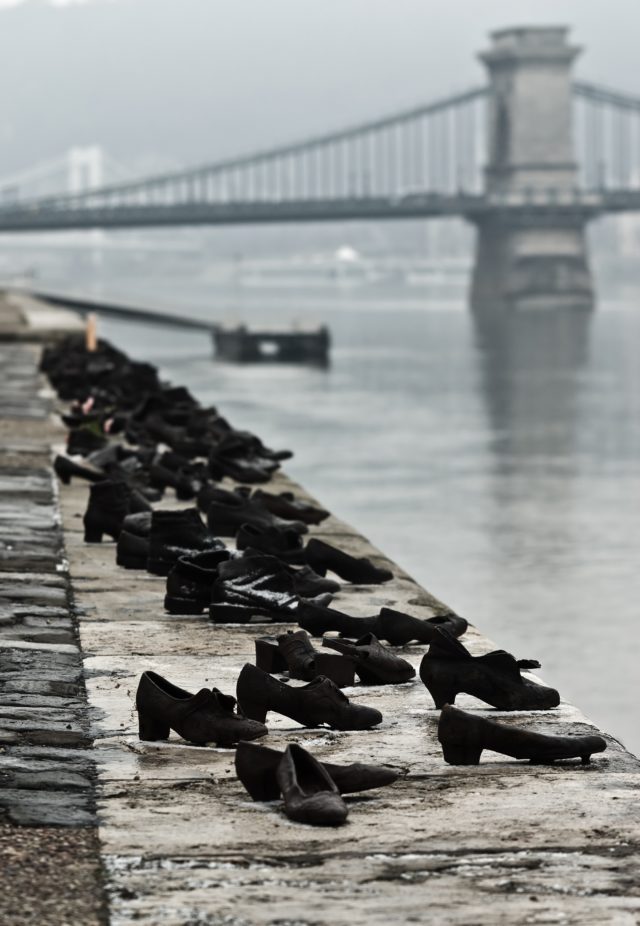
I think about the shoes.
I think about the shoes; 60 of them, lined along the east bank of the Danube River in Budapest, Hungary. They don’t belong to anyone in particular, and they’re not real shoes, either. They’re rusted iron totems, sober reminders of how cold the world can be.
“Shoes on the Danube Bank” was conceived by Hungarian film director Can Togay and sculpted by Gyula Pauer to memorialize the Jewish men, women and children who were executed here by the Arrow Cross militiamen during the Second World War.
Formed in 1939 in Hungary, alongside another bunch of fascist hooligans to the northwest, the Arrow Cross party was an efficient bunch — murdering anywhere from 10,000 to 15,000 and deporting roughly 80,000 more to Austrian concentration camps — all before their defeat in 1945. Murder on that level makes the mind reel.
“Shoes on the Danube Bank” is not a large memorial, maybe 100 feet or so, and if it weren’t pointed out by our guide, few on the tour bus would have noticed the shoes glinting in the midday sun. As the story goes: Men, women and children were lined up along the bank of the Danube, told to step out of their shoes, strip naked and face the water. They were then shot at close range so their bodies tumbled into the Danube and floated out of sight. I guess the Arrow Cross couldn’t be bothered to dig a mass grave. The tourists on the bus gave an appropriate groan of disgust, to which the guide solemnly nodded. And then, before you could think a thought, the driver’s foot was back on the gas and we were off to lunch.
I would suspect that, for most of the tourists, the second we left the shoes, the shoes left them. Holocaust memorials in Eastern Europe aren’t exactly rare, and few pay this much money to come and feel sad about the past. Nevertheless, the shoes stayed with me. I could think of little else.
I thought about what they might’ve thought about, standing there naked and cold. What does one think about in those final moments?
I thought about the optimists, the ones who tried to obey every order, no matter how humiliating and ridiculous, in hopes of being spared.
I thought about the fatalists, those who knew what was about to happen and simply resigned. I’ve heard of “suicide by cop;” was there such a thing as “suicide by Gestapo”?
I thought about the children and secretly hoped they had been shot first and spared the horror of listening to what was happening right next to them.
No matter how hard I tried, I couldn’t shake the shoes. Prior to this trip, my family had gone through a tragedy of sorts, one that caused me to stuff my carry-on with anger, sadness and disappointment. Now, all that emotional baggage seemed minuscule compared to those shoes. How dare I carry on a personal pity party in the presence of real pain and suffering? But, as I have learned time and time again, the pain of another does little to alleviate the pain within. All it does is create despair.
Thankfully, I needn’t have despaired long for the very antidote I sought was contained in the novel I’d brought along. In it, a character recounts the story of Carl Jung, the famed Swiss psychologist, building Bollingen Tower. After his mother’s death in 1922, Jung bought a small parcel of land in Bollingen along the banks of Lake Zürich. Jung lived nearby, in a residential part of the area, but felt he needed a special secluded place to himself where he could go and work out bigger things. On this plot of land, Jung built a small tower, stone by stone, laying each one with his own hands. After his wife died in 1955, Jung added a second story to the tower. Initially, the tower was modeled after the huts Jung saw on a visit to Africa, open and simple, but as time went on, Jung found the need to add partitions and decorations.
Nowadays, Jungian scholars consider Bollingen Tower a three-dimensional mandala, and inside this mandala, that Jung built with his own hands after losing his mother and wife, exists a stone with a hand-chiseled inscription: “Cold or not, God is present.”
Bollingen Tower is not open to the public, so even if I did fly to Zürich, I couldn’t verify that the inscription exists — though I do suspect the author was making a play on the phrase, “Called or not, God is present.” But the more I thought about it, the more “cold” seemed to fit. I’m sure it was cold in that drafty tower, probably a lot colder after Jung’s wife died. I’m sure it was cold standing naked along the banks of the Danube, probably a lot colder once they heard the crack of the gun and knew exactly what was happening. Cold or not, God is present.
It’s an awfully cold world out there, and a damn tough one to rationalize. Abominable phrases like, “He works in mysterious ways,” have always sounded like apathetic shrugs to me. Real “How the hell should I know?” admissions. But not this. This was something different, something that’ll stick to my ribs no matter how cold it gets: 60 iron shoes along the bank of the Danube and six words from a novel.
I’ll never forget those shoes.














